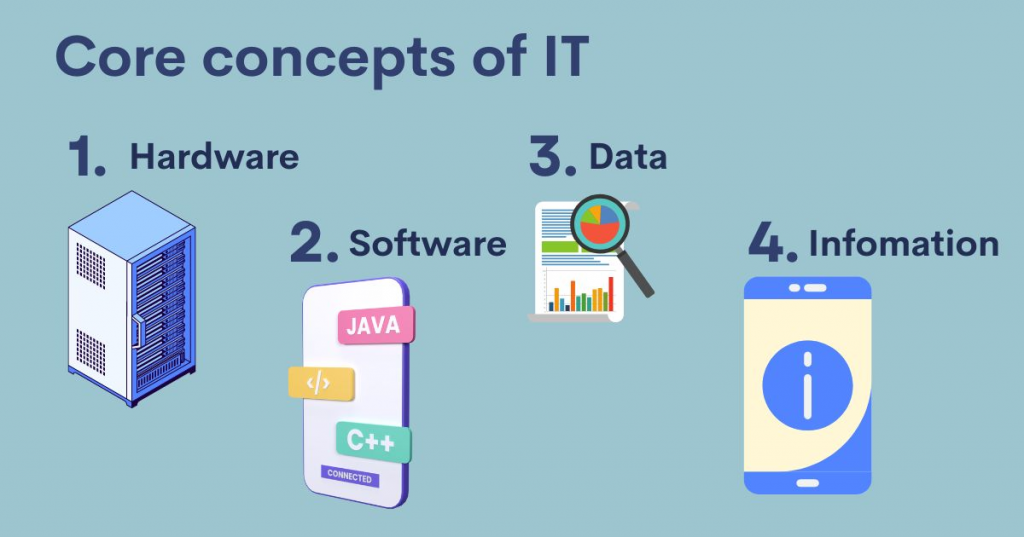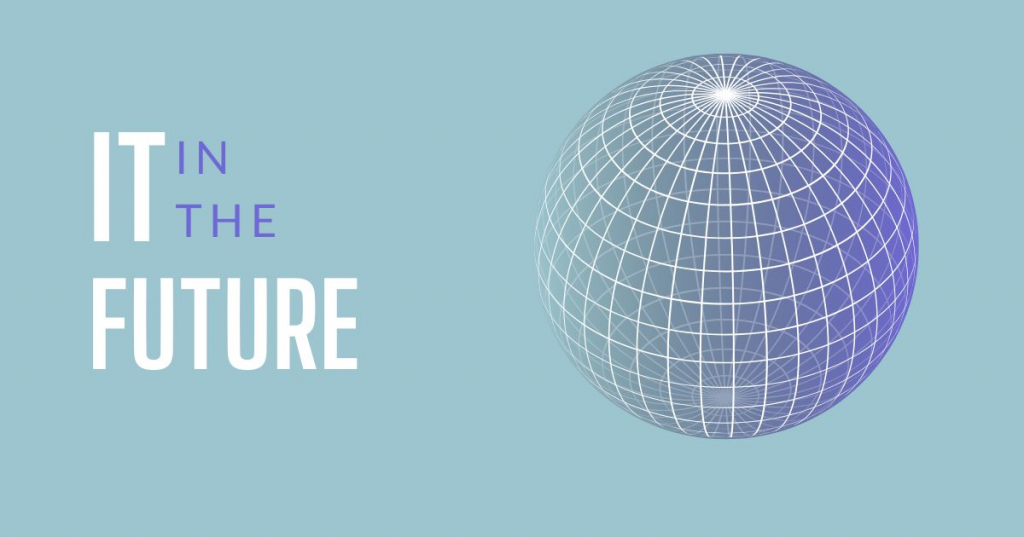What is Information Technology? Concepts & Future of IT
This blog dives deep into the how's and why's of Information Technology (IT), exploring its applications that touch every aspect of our lives, and peering into the future to see what groundbreaking advancements await. Whether you're a tech enthusiast or just curious about how IT works, this blog is for you.
Keep reading!
Introduction to Information Technology
Information technology (IT) is all around us, silently shaping the way we live and work. But what exactly is it?
What is information technology?
According to Wikipedia, IT is defined as follows:
"Information technology (IT) is a set of related fields that encompasses computer systems, software, programming languages and data and information processing and storage. IT forms part of information and communications technology (ICT) An information technology system (IT system) is generally an information system, a communications system, or, more specifically speaking, a computer system — including all hardware, software, and peripheral equipment — operated by a limited group of IT users, and an IT project usually refers to the commissioning and implementation of an IT system."
In a nutshell, IT is the use of computers and other electronic devices to store, retrieve, transmit, and manipulate information. It's the backbone of the digital world, encompassing everything from the computers we use to the vast networks that connect them.
Think of it as a giant toolbox filled with tools for handling information:
Hardware: The physical components like computers, tablets, smartphones, servers, and routers.
Software: The programs that run on the hardware, like operating systems, applications, and web browsers.
Networks: The infrastructure that connects all these devices, allowing information to flow freely.
Why is IT Important?

IT's importance can't be overstated. It's woven into the fabric of our daily lives, both personally and professionally.
Here's a glimpse of why IT is so crucial:
Communication: IT allows us to connect and share information instantly across vast distances. We can stay in touch with loved ones, collaborate with colleagues, and access a world of knowledge through email, social media, video conferencing, and the internet.
Efficiency: IT automates tasks, streamlines processes, and facilitates data analysis, saving us time and resources. Businesses use IT to manage inventory, track sales, and improve customer service.
Innovation: IT fuels constant advancements in various fields. From medical research to engineering, IT helps us develop new technologies, solve complex problems, and create a better future.
Access to Information: IT grants us access to a vast ocean of information through the internet. We can learn new skills, conduct research, and explore diverse viewpoints with just a few clicks.
In short, IT is the engine that drives the information age. It empowers us to connect, create, and innovate in ways never before imagined.
To better understand the importance and influence of IT on the world, we will go into the next sections.
Core concepts of Information Technology

The world of IT revolves around a few fundamental building blocks. Let's delve into these core concepts to understand how they work together.
Hardware
Imagine a bustling city - IT functions similarly. Hardware (the physical components) are like the buildings and roads that make everything run. This essential infrastructure includes:
Computers: These are the workhorses, processing data and running programs. We have desktops, laptops, tablets, and powerful servers, each with its own role.
Devices: These are our gateways to the digital world. Smartphones, printers, scanners, and other peripherals connect us to the information we need.
Networks: These are the information highways, connecting all these devices and allowing data to flow freely. Networks can be wired or wireless, local or global.
Software
Think of software as the brain of the operation. It provides the instructions that tell the hardware what to do. There are two main categories:
Operating Systems: These are the core programs that manage the computer's resources and provide a platform for other software to run. Examples include Windows, macOS, and Linux.
Applications (Apps): These are specialized programs designed to perform specific tasks. We have word processors, web browsers, games, and countless other apps that cater to our diverse needs.
Data
Data is the lifeblood of IT. It's the raw, unprocessed information that gets fed into the system. Data can take many forms: numbers, text, images, audio, video, you name it! Data itself isn't inherently useful, but it holds the potential to become valuable information.
Information
Information is processed data that is organized, structured, and meaningful. It's the knowledge gained from analyzing raw data. This is where IT systems excel at taking seemingly random data points and transforming them into insights that can be used for decision-making, problem-solving, and creating new knowledge.
How has IT affected the world?
Information Technology (IT) has infiltrated every corner of our lives, transforming how we function in the world. Here's a glimpse into how IT applications have revolutionized various sectors:
Businesses
IT is the backbone of modern businesses, streamlining operations and boosting productivity. Here are some key applications:
Operations Management: IT automates tasks, manages inventory, and facilitates data analysis, allowing businesses to run more efficiently.
Communication and Collaboration: Email, video conferencing, and project management tools enable seamless communication and collaboration within teams and across locations.
E-commerce: IT powers online stores, making it possible to buy and sell goods virtually, expanding market reach and offering 24/7 accessibility.
Education
IT has transformed education, creating new avenues for learning and knowledge sharing:
Online Learning: E-learning platforms and online courses offer flexible learning opportunities, making education accessible to a wider audience.
Research Tools: Students and researchers have access to vast online databases, libraries, and collaborative tools, fostering in-depth exploration of any topic.
Interactive Learning: Educational software and simulations provide engaging and interactive learning experiences, making education more effective and enjoyable.
Healthcare
The healthcare industry has seen a dramatic shift with IT applications:
Electronic Health Records (EHRs): IT allows for secure storage and access to patient medical records, improving care coordination and treatment planning.
Medical Devices: Advanced medical devices like MRI machines and robotic surgery systems rely heavily on IT for precise operation and data analysis.
Telemedicine: Remote consultations and patient monitoring are now possible through video conferencing and wearable health trackers, expanding access to healthcare services.
Everyday Life
IT has become an indispensable part of our daily lives, influencing how we connect, relax, and stay informed:
Communication: We can stay in touch with loved ones worldwide through instant messaging, social media, and video calls.
Entertainment: Streaming services, online gaming, and digital music platforms provide endless entertainment options at our fingertips.
Social Media: IT connects us to global communities, allowing us to share experiences, ideas, and news in real-time.
These are just a few examples of how IT applications have transformed our world. As technology continues to evolve, we can expect even more innovative applications that will redefine the way we live, work, and interact with the world around us.
What will the IT field be like in the future?

The world of IT is a dynamic one, constantly pushing the boundaries of what's possible. Here's a peek into some of the emerging trends that are shaping the future of IT:
Emerging Trends
Several groundbreaking trends are poised to revolutionize the way we interact with technology:
Artificial Intelligence (AI): AI is rapidly transforming various sectors. Machine learning algorithms will become even more sophisticated, automating tasks, analyzing data with unprecedented accuracy, and driving innovation across industries.
Cloud Computing: Cloud-based solutions will become increasingly prevalent. Storing data and running applications on remote servers will offer greater scalability, flexibility, and cost-effectiveness for businesses and individuals alike.
Internet of Things (IoT): The interconnection of everyday devices with the internet (IoT) will create a vast network of intelligent devices that collect and exchange data. This will lead to smarter homes, cities, and industries, with greater automation and efficiency.
The Societal Impact of IT
The influence of IT on society is undeniable, and it comes with both benefits and challenges:
Job Market Changes: Automation through AI and robotics will undoubtedly reshape the job market. While some jobs will become obsolete, new opportunities will arise in areas like IT development, data analysis, and AI management.
Ethical Considerations: As IT becomes more powerful, ethical considerations become paramount. Issues like data privacy, bias in algorithms, and the potential misuse of AI require careful consideration and responsible development.
The future of IT promises exciting advancements that will reshape our world. It's crucial to embrace these changes while acknowledging the potential challenges and working towards responsible development to ensure a future where technology empowers and uplifts humanity.
Conclusion
Our exploration of Information Technology partly explains to readers the question "What is Information Technology?". Here's a quick recap of the key points:
IT is the foundation of the digital age, encompassing hardware, software, data, and information.
It empowers us to connect, create, and innovate through powerful applications in business, education, healthcare, and everyday life.
From streamlining operations to revolutionizing communication, IT has become an indispensable tool for progress.
As we move forward, it's crucial to embrace the power of IT while acknowledging its potential pitfalls.
By fostering responsible innovation and developing skills to navigate the changing landscape, we can ensure that IT continues to be a force for good, shaping a brighter future for all.



